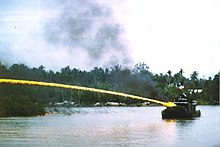Incendiary material
When fire warfare agents are chemical compounds that are used militarily and hard trigger to delete fires. The best known incendiary agents are phosphorus and napalm . In most cases incendiary weapons are brought into the target area.
history
The principle of an incendiary material was first applied in the early Middle Ages through the so-called Greek fire . In the Second World War came phosphorous bombs notoriety. During the Second World War - in 1942 - American scientists developed napalm as a weapon against tanks. However, it was used primarily against German and Japanese cities. Napalm owes its fame today primarily to its use in the Korean and Vietnam wars . But it was also used by the Soviet army against Afghan resistance fighters. A UN convention from 1980 prohibited the use of incendiary substances against the civilian population. The US never joined this treaty.

Protective measures
In addition to severe burns, the main danger when using incendiary agents is the removal of oxygen and the formation of toxic and / or asphyxiating gases such as B .: carbon monoxide , carbon dioxide , nitrogen oxides or even cyanides . The usual fire protection measures apply, i. H. immediate removal of burning clothing and material. Extinguishing is very difficult because napalm spreads very quickly. It is even possible to crawl up walls. Drainage channels and earthfills can prevent the flame carpet from spreading. Burning rooms must be vacated immediately. Extinguishing work is often hampered by thick, acrid smoke. Burn wounds should be treated as soon as possible.
See also
Web links
- Information about various means of fire. feuerwehr-halle.de
